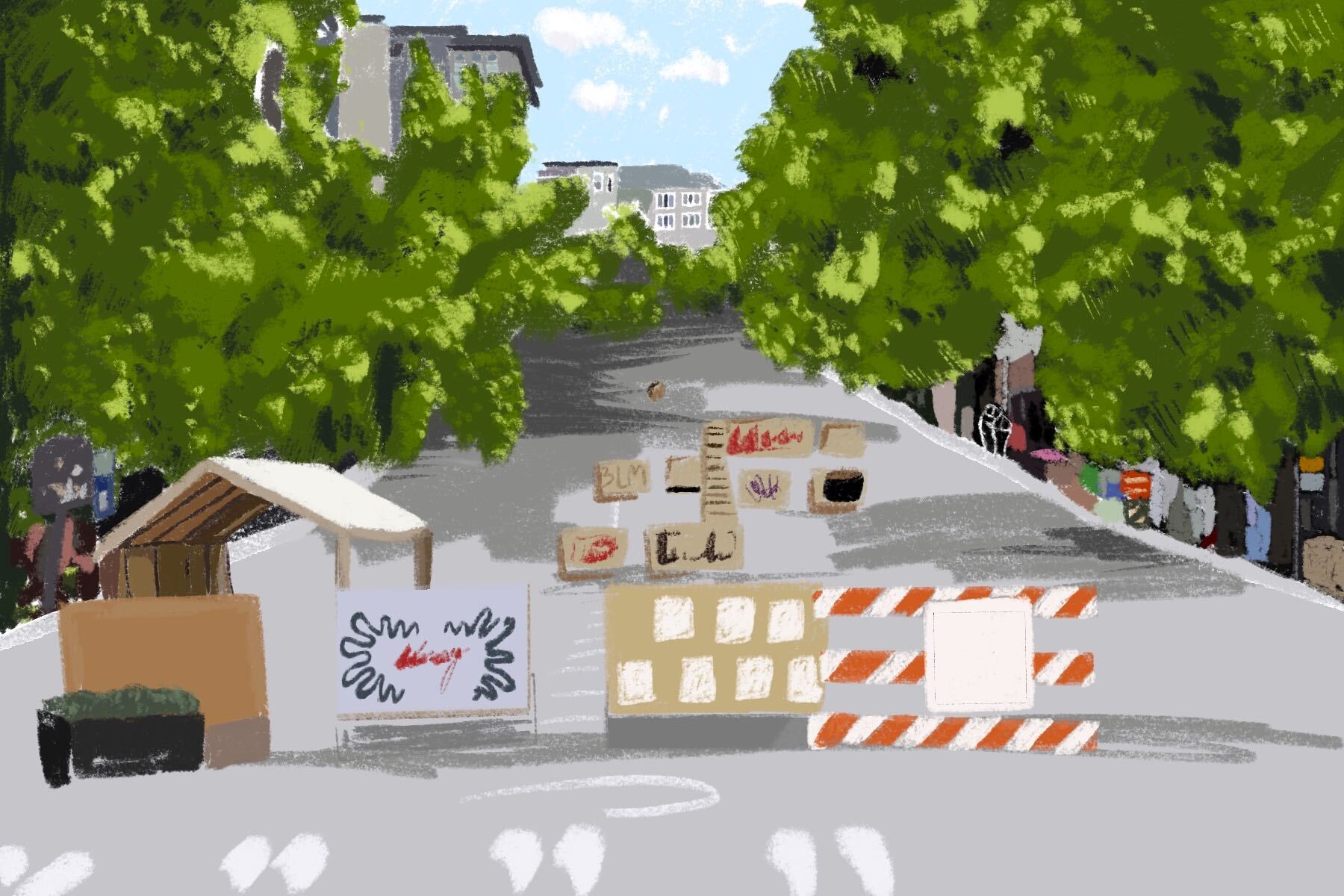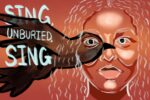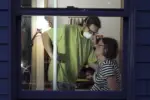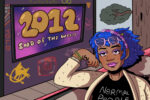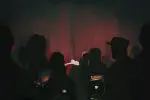When 20-year-old university student Zaya (whose name has been changed for this article) entered Seattle’s “Capitol Hill Occupied Protest,” otherwise known as the “CHOP,” it was more out of coincidence than deliberate action. She and her mother were only in Seattle to attend a bridal shower. Gearing up to head home with a last-minute coffee run, Zaya’s plans changed when a man mentioned that the CHOP was “just around the corner” from the café.
The two entered the CHOP from the north end of Cal Anderson Park, initially spotting only a cluster of tents and mistaking it for a homeless encampment. “I didn’t really know what to expect because I hadn’t really seen pictures of it before,” she recalled. Despite playing an active role in signing petitions, reading about ongoing protests (including the CHOP) and often being the one to educate family members about the Black Lives Matter movement, Zaya couldn’t paint a concrete image of the area in her mind before her visit.
Indeed, the CHOP’s composition has been thoroughly difficult to nail down from the outside looking in. Originally called the “CHAZ” for “Capitol Hill Autonomous Zone,” the area (including a police precinct) was occupied by protesters starting on June 9, after long and occasionally violent demonstrations against the murder of George Floyd. Law enforcement was not allowed inside, as street access was blocked off with concrete barriers and monitored by a group of volunteers. This is where the facts largely end, and speculation begins: a New York Post article called the area “a continuing experiment in anarchy, chaos and brute-force criminality,” while a piece by Vox stated that the “neighborhood has flourished since police left the area to protesters.”
Zaya was already skeptical of most mainstream news outlets and their coverage of the CHOP. “There also isn’t that much media coverage on … the good parts of it. All the [mainstream news] covers is when the police go off. They don’t cover what leads up to that.” She had seen Facebook posts from friends and family that condemned the protest, but Zaya was wary of accepting those statements at face value. Her hour-long visit on June 21 convinced her that these accusations were unwarranted.
Not Just a Walk in the Park
Heading south past the tents in Cal Anderson Park, Zaya was surprised to discover that there was more to the CHOP than just an encampment: the nearby Bobby Morris Field had been occupied as well, serving as a multi-purpose space for protestors. “There were people doing organized yoga … there were people teaching each other how to defend themselves in a fight, there were people just playing music. Just people running around playing games. There were tents lining the edges of the field but nothing in the middle.” Zaya also recalled a distinct image of Black women practicing yoga on the Bobby Morris Field, surrounded by a chain of protestors who formed to protect them from any outside interference.
Beyond the Bobby Morris Field is East Pine Street, home of the now-defunct East Precinct of the Seattle Police Department. Many vendors populated the street to create a makeshift farmers market, giving away free food and supplies to anyone who approached them. In Zaya’s eyes, the CHOP appeared to be self-sufficient, even featuring a community garden that hosted a variety of crops. “Everything you could ask for is there … supplies, a place to sleep, community, self-defense.”
The East Precinct itself was unoccupied. Zaya had taken photos of the site, which was boarded up with plywood and covered in graffiti that carried a wide range of messages. One reads, “Fire Steven McNew,” referencing an officer who shot and killed a pregnant Black woman, Charleena Lyles, in 2017 after she had reported a burglary. Another states, “If Seattle is so progressive, decriminalize entheogens and plant medicine just like Denver, Oakland and Santa Cruz have done.” The most widely publicized graffiti from the precinct is likely the sign that adorns its entrance, which now reads, “Seattle People Department.”
Several lawn chairs had been set up outside the precinct for guards to watch over the area. In Zaya’s photos, two of these guards can be seen talking: one, in a black hoodie and sweatpants, is looking at something on a smartphone. The other, wearing a black shirt and pink shorts, drinks from a disposable coffee cup. Neither appears to be armed. Both are wearing crocs.
Zaya was quick to mention how this image contradicts those depicting militancy at the CHOP. “You know how [the guards] get portrayed on media as these really intimidating, scary people who are strapped and guarding the entrances … that’s just not the case. [One of them] was just this chill white dude, sitting in a lawn chair just saying ‘Hi’ to everyone, with a little radio on his belt. That’s it.” It is worth noting that demonstrators within the CHOP have mentioned guards carrying concealed weapons before, but Zaya did not observe the presence of any weapons while on site.
After exploring the site, reading graffiti messages, talking with demonstrators and approaching vendors, Zaya returned the way she came, passing a 30-foot-tall Black Lives Matter fist in the Bobby Morris Field. Her time in the CHOP was brief, but its impact would last far beyond the flight home.
An Identity of Its Own
“I’m sure there was stuff going on behind the scenes, but out in public, it was just people living.” Something Zaya noted during her time in the CHOP was how the politics of its existence were only a small percentage of the conversation taking place within the community. Many people were just going about their day, taking yoga classes or growing crops amid the backdrop of an ongoing protest.
Zaya said that the CHOP could be something akin to a communist society, pointing out that labels and economic status had no real impact on how one was treated within the CHOP, which largely operated without money. The emphasis on communal bonds was “revitalizing” for Zaya, who had felt weighed down by the animosity of living in cities and suburbs. “I think what [made it a revitalizing experience] was the innocence and the pure community … nobody cared what you looked like, nothing mattered. You don’t really get that sense of community anymore in our society. Especially [during the pandemic].”
While the makeshift nature of CHOP’s vendors and gardens has dissuaded some from accepting its community model, Zaya noted a demographic that directly benefitted from open access to consolidated resources: the homeless population. “It gave a safe haven for a lot of homeless people to get food. Have a community to talk to. Be safe. Not worry about getting jumped every night when they go to bed.”
Beyond CHOP
The CHOP was disbanded by police on July 1, less than a month after it was established and a mere 10 days after Zaya’s visit. “Honestly, I did expect the CHOP to get dismantled,” Zaya noted. “They had taken up so much space. Especially since it’s a police precinct, you know, [the police] have got big egos. They weren’t gonna let [demonstrators] keep it for too long.”
The final days of the CHOP saw a shooting that resulted in the death of a 16-year-old – one of four shootings that took place in the CHOP and its surrounding area. Many have criticized the CHOP for this reason, deeming it a failed experiment and proof that an anti-police or self-policing society cannot function. Zaya doesn’t see it that way, stating in reference to the latest shooting: “You’re gonna get crazy people no matter where you go. You can’t blame the entire CHOP for one person’s actions.”
She also rebutted with an example of success in demilitarizing police: a 55% drop in NYPD arrests in 2014 that generally saw similar or lower crime rates, despite the drastic decrease in police presence. “I personally don’t think we should absolutely abolish the police, but I do think we should defund and reform the police,” she clarified.
The CHOP has remained a topic of intense discourse and controversy, but Zaya still believes in its promise: “It set out to be a safe haven. And I think it was successful in that. For the time it was there … most people greatly benefitted from the community that they had made. They were a part of something again.” The conversation has continued with attempts to mirror the CHOP in cities like Portland, where a friend of Zaya is still actively working to establish an occupation with similar goals in mind.
While the zone itself may no longer exist, Zaya’s visit endures in her mind, as a reminder to actively manifest and advocate for ideals that fueled the CHOP in the first place. “Me going to the CHOP – I did absolutely nothing. I didn’t participate. I just visited. You need to actively do things on your own to make a difference.”


